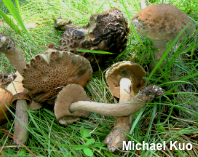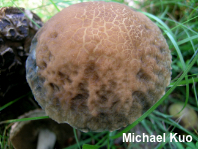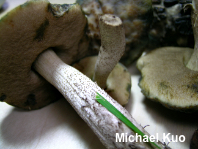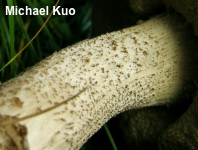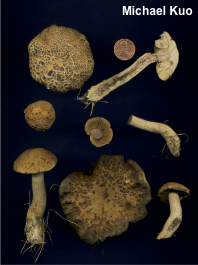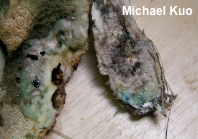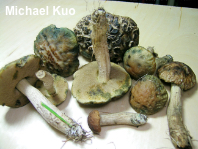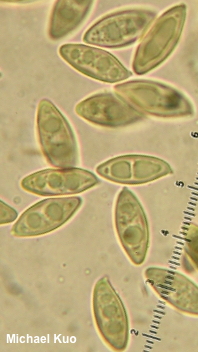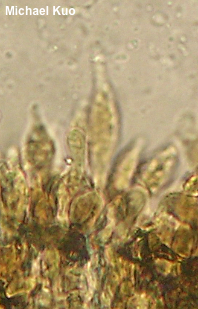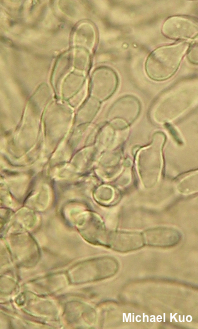| Major Groups > Boletes > Leccinum > Leccinum quercophilum |

|
Leccinum quercophilum [ Basidiomycota > Boletales > Boletaceae > Leccinum . . . ] by Michael Kuo I walk 5K every day, at a pretty good clip. I imagine you've seen someone like me and rolled your eyes—but at least I don't do that thing with the arms, or carry little weights, or any of that stuff that "speedwalkers" do. I just walk, fast enough to get my heart and psychology pumping. The thing is, when there has been rain and mushrooms are popping up all over town, I wind up stopping a lot, and exercise takes a back seat. I know I should keep going and keep my heart rate up, but . . . mushrooms! Leccinum quercophilum is the result of my inability to make healthy choices. On my daily walk in July of 2008, I passed a yard full of boletes and russulas, and just had to circle back. Particularly interesting were some cracked-topped boletes with blue stains on the stems and cap margins, and rows of tiny brown scabers on the stems. The mushrooms looked like a species of Leccinum, but not one I recognized. When I got home I gathered my equipment and went back to the yard (yes, I drove, just don't worry about it) and collected what would eventually turn out to be the type collection of a new species. Distinguishing features for Leccinum quercophilum include the association with oaks, the dull brown, pitted cap that becomes cracked, the blue staining, and the longitudinal rows of very fine, brown scabers. Under the microscope, its pileipellis is a trichoderm. It is similar to Leccinum pseudoscabrum (also known as Leccinum carpini), but the latter species is associated with Carpinus rather than oaks, has flesh that stains violet when sliced, and does not stain blue (except very rarely in the stem base). Leccinum pseudoscabrum may be limited to Europe, but further study is needed before that declaration can be made with certainty. Another similar mushroom is the "Leccinum griseum" found in North American guides, but there are several problems with this name (see den Bakker & Noordeloos, 2005) and it has not been applied consistently. At least some portion of what is called Leccinum griseum in Europe is probably Leccinum pseudoscabrum, and much of what North American authors and collectors call Leccinum griseum is probably Leccinum crocipodium or Leccinum quercophilum. "Probably," "probably." Obviously more study is needed! Leccinellum quercophilum is a previous name; when I first published the species (Kuo and collaborators 2013) the genus name Leccinellum was in use for species in this group, but more recently (Kuo & Ortiz-Santana, 2020) Leccinellum has been collapsed into a broadened Leccinum. Thanks to the University of Michigan Herbarium (MICH) for facilitating study of the collections cited below. Description: Ecology: Mycorrhizal with oaks; growing gregariously; summer; possibly widely distributed in North America east of the Great Plains. The illustrated and described collections are from Illinois and Michigan. Cap: 3–9 cm; convex, becoming broadly convex; dry; bald; tightly wrinkled and pitted when young; becoming cracked and mosaic-like with age; orangish brown to yellowish brown; discoloring bluish green toward the margin with age; without a sterile overhanging margin. Pore Surface: Whitish to grayish brown when young, becoming yellowish brown to brownish with age; bruising slowly dark brown, with or without a bluish stage; with 1–3 angular pores per mm at maturity; tubes 1–2 cm deep; by maturity usually depressed at the stem. Stem: 5–9 cm long; 8–20 mm thick; gradually tapering to apex; whitish underneath fine, tiny scabers that are whitish above and brown below, arranged in vague longitudinal lines; bruising and staining greenish to blue near the base; basal mycelium white. Flesh: Whitish; staining grayish to gray within 30 minutes of exposure, with or without a faintly pinkish stage; sometimes bluing in the stem base. Odor and Taste: Not distinctive. Chemical Reactions: Ammonia negative on cap surface; negative to pinkish on flesh. KOH negative to yellowish on cap surface; gray to greenish gray on flesh. Iron salts negative on cap surface; negative or greenish on flesh. Spore Print: Not recorded. Microscopic Features: Spores 15–18 x 5–7.5 µm; fusiform; smooth; yellowish in KOH; inamyloid. Basidia 25–30 x 9–12 µm; clavate; 4-sterigmate. Pleurocystidia 25–40 x 8–12 µm; lageniform; smooth; thin-walled; hyaline to yellowish or golden in KOH. Cheilocystidia 30–50 x 10–15 µm; lageniform to mucronate, subclavate, or irregular; thin-walled; smooth; yellowish to brownish in KOH. Pileipellis a trichoderm of septate hyphae, hyaline to yellowish or brownish in KOH; terminaland subterminal elements subglobose to clavate or irregular, 25–50 µm wide. Caulocystidia lageniform or ventricose-rostrate; smooth; 30–50 x 10–15 µm; hyaline to yellowish in KOH. REFERENCES: (M. Kuo, 2013) M. Kuo & B. Ortiz-Santana, 2020. (Kuo et al., 2013; Bessette et al., 2016; Kuo & Ortiz-Santana, 2020.) Herb. Kuo 07120801 (holotype), 06201003. Herb. MICH 35770, 35774. This site contains no information about the edibility or toxicity of mushrooms. |
© MushroomExpert.Com |
|
Cite this page as: Kuo, M. (2020, January). Leccinum quercophilum. Retrieved from the MushroomExpert.Com Web site: http://www.mushroomexpert.com/leccinum_quercophilum.html |
